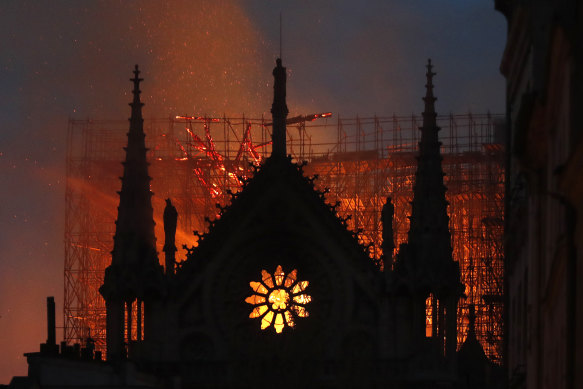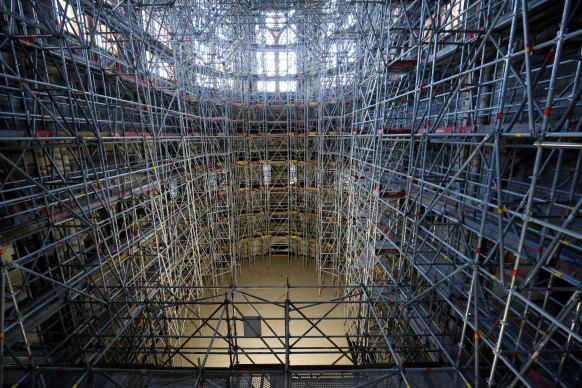
Notre Dame had been Paris’ most-visited tourist attraction, a masterpiece of Gothic architecture that lured more than 12 million visitors each year. But many people in France also embraced it as a cultural symbol, a visual anchor of Paris and a reminder of the Catholic traditions that undergird a proudly secular republic.

Flames and smoke rise as the spire on Notre Dame cathedral collapses in Paris.Credit:AP
The cathedral’s iconic bell towers and elaborate stained glass withstood the flames. The Crown of Thorns, which Jesus purportedly wore during his crucifixion, was saved. But the roof collapsed, the medieval wooden interior was obliterated, and many artefacts were lost. The cause of the fire remains unknown.
Standing in front of Notre Dame that night, with smoke still billowing, President Emmanuel Macron vowed, “We will rebuild this cathedral”. His hope was to have it ready for visitors by July 2024, when France is hosting the Summer Olympics. But French officials say they are now aiming for the end of 2024.
“We will have two extraordinary events in France in 2024: the Olympic Games and the reopening of Notre Dame,” Jean-Louis Georgelin, the French army general overseeing the project, told journalists touring the wood workshop on Thursday. “The image of France is at stake in those two events.”
Villeneuve had been involved at Notre Dame before the fire, overseeing repair work since 2013. He wasn’t in Paris when the first fire engines rushed to the cathedral. But as soon as he heard, he jumped on the last train from the Atlantic coast.

Flames and smoke rise from Notre Dame Cathedral as it burns on April 15, 2019 in Paris. Credit:AP
“Luckily, I didn’t see the spire fall,” he said. “I don’t think I really would have recovered from that.”
In the following days, he and his team identified the most destabilised parts of the cathedral. As workers secured the building over the following two years, French architects, church representatives and politicians sparred over how to rebuild.
Some architects proposed reconstructing the collapsed roof as a greenhouse, or with stained glass instead of wood, or even replacing it entirely with a swimming pool. Not all of those proposals appeared to be serious, but advocates of a modernised design argued that the fire presented a chance to start anew, as previous generations of architects had done.
Notre Dame has undergone numerous transformations in its more than 850-year history. Through the centuries, the cathedral’s windows were widened and the flying buttresses reconstructed. After an old spire was removed over safety concerns in the 18th century, the cathedral went decades without its now most iconic feature. Under the architectural leadership of Eugène Emmanuel Viollet-le-Duc, Notre Dame was subject to such dramatic changes in the 19th century that many scholars today say the building is more representative of that period than of its medieval origins.

Notre-Dame cathedral is pictured on June 16, 2021, two years after the cathedral was ravaged by fire.Credit:AP
Successive French presidents have been eager to leave their imprint on the centre of Paris, personally championing projects such the Louvre pyramid and Pompidou Centre. Macron, who had been elected on a platform of a renewal two years before the fire, suggested a “contemporary architectural gesture” in the new spire design. But after a backlash – including a threat by architect Villeneuve to resign – he embraced a reconstruction closely replicating the original.
It will look different in some ways, though.
“Before the fire, we had a very dirty cathedral – walls that looked almost black or dark grey, because of the pollution from candles and smoke,” said Sandron, the art historian. “Now, the colour of the stones is very light.”
Aurélien Lefevre, who leads a group of carpenters working on the reconstruction, said the project remains a challenge – but not one that is insurmountable. Problems can appear at any stage, which is why the test run of assembling the wooden beams this past week was a crucial step.

A view of Notre Dame Cathedral in July 2020. It will be rebuilt just the way it stood before the fire.Credit:AP
“We’re not immune to forgetting something,” Lefevre said.
Especially for younger carpenters, being part of the project may be a once-in-a-lifetime opportunity, he said.
Nearby, dozens of carpenters were sawing, hammering and polishing wooden beams made from centuries-old oak trees. More than 1000 carefully selected trees from across France have been felled for the reconstruction.
On the edges of the workshop, the skeletons of walls for local construction projects had been pushed aside to make space for the project that will remain the priority over the next months.
Outside, Villeneuve rattled off a list of project milestones: “The galleries are finished, the north and south transept done.”
Other parts – including the spire, decoration, vault and furniture – remain works in progress. But after the shock and devastation of 2019, every sign of progress matters to those who care deeply about the building.
“It’s balm on my scars,” Villeneuve said. “By rebuilding the cathedral, I’m also rebuilding myself.”
The Washington Post









 Add Category
Add Category